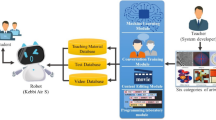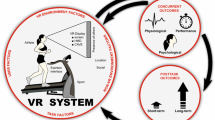Abstract
Physical education is experiencing a significant transformation due to cutting-edge technologies such as artificial intelligence (AI), machine learning (ML), virtual reality (VR), and optimization strategies. The traditional physical education classes offered by universities and colleges no longer meet the needs of modern society in terms of teaching, research, and evaluation. To address this issue, we utilized VR and ML to create a physical learning environment for university and college students. This environment allowed them to practice in a virtual setting while also learning new exercise routines. We established an immersive physical activity setting equipped with Kinect technology and VR-ready computers to create an interactive and engaging VR experience. For this, we proposed a layered architecture that includes a presentation layer, business layer, application service layer, data layer, and hardware layer. The Kinect technology is placed at the hardware layer, the database is designed and placed at the data layer, and the user interface is designed and placed at the presentation layer. The business layer is made up of support vector machine (SVM) and particle swarm optimization (PSO) which accurately classify and evaluate students’ performance in a range of physical activities on the basis of interactive and immersive VR content generated by the hardware layer. Through experimental verification, this study provides a complete framework for modernizing physical education in universities and colleges, exploring the integration of VR and optimization methodologies. The proposed method can effectively stimulate the enthusiasm of college students to learn sports, improve athletic performance and learning efficiency, as well as the overall quality of physical education instruction.











Similar content being viewed by others
Data availability
All the data are available in the paper.
References
Ali M, Yin B, Bilal H et al (2023) Advanced efficient strategy for detection of dark objects based on spiking network with multi-box detection. Multimed Tools Appl. https://doi.org/10.1007/s11042-023-16852-2
Almusawi HA, Durugbo CM, Bugawa AM (2021) Innovation in physical education: teachers’ perspectives on readiness for wearable technology integration. Comput Educ 167:104185
Aslam S, Muhammad (2021) L 2–L∞ control for delayed singular Markov switch system with nonlinear actuator faults. Int J Fuzzy Syst 23(7):2297–2308
Bond S, Laddu DR, Ozemek C, Lavie CJ, Arena R (2021) Exergaming and virtual reality for health: implications for cardiac rehabilitation. Curr Probl Cardiol 46(3):100472
Cao B, Zhao J, Gu Y, Fan S, Yang P (2019a) Security-aware industrial wireless sensor network deployment optimization. IEEE Trans Ind Inf 16:5309–5316
Cao B, Zhao J, Yang P, Gu Y, Muhammad K, Rodrigues JJ, de Albuquerque VHC (2019b) Multiobjective 3-D topology optimization of next-generation wireless data center network. IEEE Trans Ind Inf 16:3597–3605
Cao B, Gu Y, Lv Z, Yang S, Zhao J, Li Y (2020) RFID reader anticollision based on distributed parallel particle swarm optimization. IEEE Int Things J 8:3099–3107
Chen Z (2019) Observer-based dissipative output feedback control for network T–S fuzzy systems under time delays with mismatch premise. Nonlinear Dyn 95:2923–2941
Chen G, Chen P, Huang W, Zhai J (2022) Continuance intention mechanism of middle school student users on online learning platform based on qualitative comparative analysis method. Math Probl Eng 2022:1–12
Dai X, Hou J, Li Q, Ullah R, Ni Z, Liu Y (2020) Reliable control design for composite-driven scheme based on delay networked T–S fuzzy system. Int J Robust Nonlinear Control 30(4):1622–1642
Dou H, Liu Y, Chen S et al (2023) A hybrid CEEMD-GMM scheme for enhancing the detection of traffic flow on highways. Soft Comput 27:16373–16388. https://doi.org/10.1007/s00500-023-09164-y
Gao P, Li J, Liu S (2021) An introduction to key technology in artificial intelligence and big data driven e-learning and e-education. Mob Netw Appl 26(5):2123–2126
Huang C, Tu Y, Han Z, Jiang F, Wu F, Jiang Y (2023) Examining the relationship between peer feedback classified by deep learning and online learning burnout. Comput Educ 207:104910
Leilei W, Huina C (2020) Physical education image analysis based on virtual crowd simulation and FPGA. Microprocess Microsyst 79:103319
Li Q, Hou J (2021) Fault detection for asynchronous T–S fuzzy networked Markov jump systems with new event-triggered scheme. IET Control Theory Appl 15(11):1461–1473
Li H, Zhang H, Zhao Y (2021) Design of computer-aided teaching network management system for college physical education. Comput-Aid Design Appl 18(S4):152–162
Li J, Han L, Zhang C, Li Q, Liu Z (2023) Spherical convolution empowered viewport prediction in 360 video multicast with limited FoV feedback. ACM Trans Multimed Comput Commun Appl 19:1–23
Lindberg R, Seo J, Laine TH (2016) Enhancing physical education with exergames and wearable technology. IEEE Trans Learn Technol 9:328–341
Litimein H, Huang ZY, Aslam MS (2023) Circular formation control with collision avoidance based on probabilistic position. Intell Autom Soft Comput 37(1):321–341. https://doi.org/10.32604/iasc.2023.036786
Liu Y, Sathishkumar V, Manickam A (2022) Augmented reality technology based on school physical education training. Comput Electr Eng 99:107807
Liu X, Wang S, Lu S, Yin Z, Li X, Yin L, Tian J, Zheng W (2023a) Adapting feature selection algorithms for the classification of Chinese texts. Systems 11:483
Liu X, Zhou G, Kong M, Yin Z, Li X, Yin L, Zheng W (2023b) Developing multi-labelled corpus of twitter short texts: a semi-automatic method. Systems 11:390
Liu X, Shi T, Zhou G, Liu M, Yin Z, Yin L, Zheng W (2023c) Emotion classification for short texts: an improved multi-label method. Humanit Soc Sci Commun 10:1–9
Lu S, Ding Y, Liu M, Yin Z, Yin L, Zheng W (2023) Multiscale feature extraction and fusion of image and text in VQA. Int J Comput Intell Syst 16:54
Muhammad SA, Qaisar I, Majid A, Shamrooz S (2023) Adaptive event-triggered robust H∞ control for Takagi–Sugeno fuzzy networked Markov jump systems with time-varying delay. Asian J Control 25(1):213–228
Mystakidis S, Berki E, Valtanen J-P (2021) Deep and meaningful e-learning with social virtual reality environments in higher education: a systematic literature review. Appl Sci 11(5):2412
Qaisar I, Majid A, Ramaraj P (2021) Design of sliding mode controller for sensor/actuator fault with unknown input observer for satellite control system. Soft Comput 25(24):14993–15003
Qu Z, Yin J (2022) Optimized LSTM networks with improved PSO for the teaching quality evaluation model of physical education. Int Trans Electr Energy Syst 2022(3):1–12. https://doi.org/10.1155/2022/8743694
Shamrooz, Aslam M, Zhenhua MA (2023) Output regulation for time–delayed Takagi–Sugeno fuzzy model with networked control system. Hacettepe J Math Stat 1–21
She Q, Hu R, Xu J, Liu M, Xu K, Huang H (2022) Learning high-DOF reaching-and-grasping via dynamic representation of gripper-object interaction. arXiv preprint http://arxiv.org/2204.13998
Ullah R, Dai X, Sheng A (2020a) Event-triggered scheme for fault detection and isolation of non-linear system with time-varying delay. IET Control Theory Appl 14(16):2429–2438
Ullah R, Li Y, Aslam MS, Sheng A (2020b) Event-triggered dissipative observer-based control for delay dependent T–S fuzzy singular systems. IEEE Access 8:134276–134289
Ünsaler S, Hafız AM, Gökler O, Özkaya YS (2023) Virtual reality simulation-based training in otolaryngology. Virtual Real 27(3):2561–2567
Wang Y (2021) Physical education teaching in colleges and universities assisted by virtual reality technology based on artificial intelligence. Math Probl Eng 2021:1–11
Wang C, Du C (2022) Optimization of physical education and training system based on machine learning and Internet of Things. Neural Comput Appl 34(1):1–16. https://doi.org/10.1007/s00521-021-06278-y
Wu Q, Li X, Wang K et al (2023) Regional feature fusion for on-road detection of objects using camera and 3D-LiDAR in high-speed autonomous vehicles. Soft Comput 27:18195–18213. https://doi.org/10.1007/s00500-023-09278-3
Xiong Z, Liu Q, Huang X (2022) The influence of digital educational games on preschool children’s creative thinking. Comput Educ 189:104578
Yang F, Zhang J (2022) Traditional Chinese sports under China’s health strategy. J Environ Public Health 2022
YanRu L (2021) An artificial intelligence and machine vision-based evaluation of physical education teaching. J Intell Fuzzy Syst 40(2):3559–3569
Zhenhua M, Ullah R, Li Y, Sheng A, Majid A (2022) Stability and admissibility analysis of T–S descriptive systems and its applications. Soft Comput 26(15):7159–7166
Zhou J (2021) Virtual reality sports auxiliary training system based on embedded system and computer technology. Microprocess Microsyst 82:103944
Funding
No funding was provided for the completion of this study.
Author information
Authors and Affiliations
Corresponding author
Ethics declarations
Conflict of interest
There is no conflict of interest between the authors.
Additional information
Publisher's Note
Springer Nature remains neutral with regard to jurisdictional claims in published maps and institutional affiliations.
Rights and permissions
Springer Nature or its licensor (e.g. a society or other partner) holds exclusive rights to this article under a publishing agreement with the author(s) or other rightsholder(s); author self-archiving of the accepted manuscript version of this article is solely governed by the terms of such publishing agreement and applicable law.
About this article
Cite this article
Wang, J., Yang, Y., Liu, H. et al. Enhancing the college and university physical education teaching and learning experience using virtual reality and particle swarm optimization. Soft Comput 28, 1277–1294 (2024). https://doi.org/10.1007/s00500-023-09528-4
Accepted:
Published:
Issue Date:
DOI: https://doi.org/10.1007/s00500-023-09528-4




